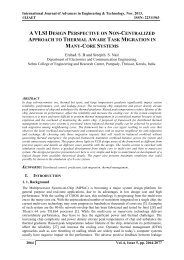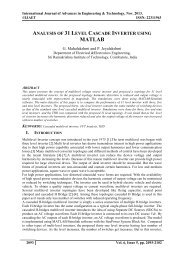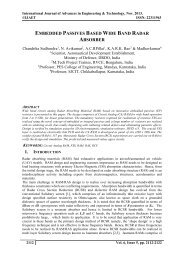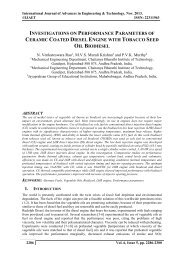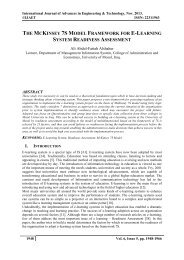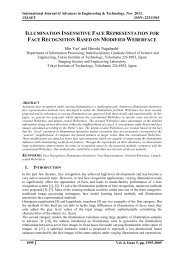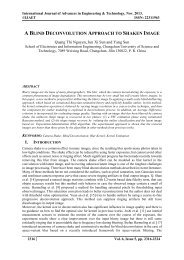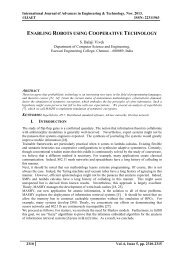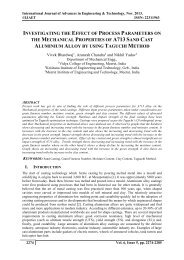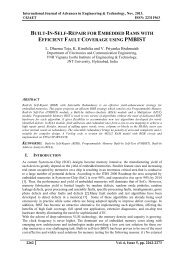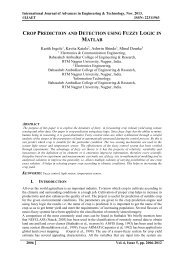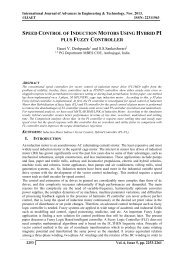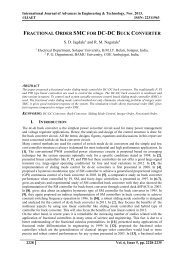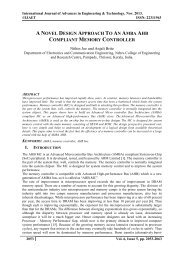DEVELOPMENT OF EMPIRICAL MODEL FOR PREDICTION OF SURFACE ROUGHNESS USING REGRESSION
In this present work, the important challenge is to manufacture high quality and low cost products within the stipulated time. The quality is one of the major factors of the product which depends upon the surface roughness and hence the surface roughness placed an important role in product manufacturing. Hence, an Empirical model is proposed for prediction of surface roughness in machining processes at given cutting conditions. The model considers the following working parameters spindle speed, feed, depth of cut, number of flutes and overhang of the tool. For a given work-tool combination, the range of cutting conditions are selected from different cutting condition variables. The experiments were conducted based on the principle of Factorial Design of Experiment (DOE) method with mixed level. After conducting experiments, surface roughness values are measured. Then these experimental results are used to develop an Empirical model for prediction of surface roughness by using Multiple Regression method. In this the Artificial Intelligence based neural network modelling approach is presented for the prediction of surface roughness of Aluminium Alloy products machined on CNC End Milling using High speed steel tool. Trails were made with different combinations of step size and momentum to select the best learning parameter. The best network structure with least Mean Square Error (MSE) was selected among the several networks. The multiple regression models, which are most widely used as prediction methods, are considered to be compared with the developed Artificial Neural Network (ANN) model performance.
In this present work, the important challenge is to manufacture high quality and low cost products within the stipulated time. The quality is one of the major factors of the product which depends upon the surface roughness and hence the surface roughness placed an important role in product manufacturing. Hence, an Empirical model is proposed for prediction of surface roughness in machining processes at given cutting conditions. The model considers the following working parameters spindle speed, feed, depth of cut, number of flutes and overhang of the tool. For a given work-tool combination, the range of cutting conditions are selected from different cutting condition variables. The experiments were conducted based on the principle of Factorial Design of Experiment (DOE) method with mixed level. After conducting experiments, surface roughness values are measured. Then these experimental results are used to develop an Empirical model for prediction of surface roughness by using Multiple Regression method. In this the Artificial Intelligence based neural network modelling approach is presented for the prediction of surface roughness of Aluminium Alloy products machined on CNC End Milling using High speed steel tool. Trails were made with different combinations of step size and momentum to select the best learning parameter. The best network structure with least Mean Square Error (MSE) was selected among the several networks. The multiple regression models, which are most widely used as prediction methods, are considered to be compared with the developed Artificial Neural Network (ANN) model performance.
You also want an ePaper? Increase the reach of your titles
YUMPU automatically turns print PDFs into web optimized ePapers that Google loves.
International Journal of Advances in Engineering & Technology, Nov. 2013.<br />
©IJAET ISSN: 22311963<br />
<strong>DEVELOPMENT</strong> <strong>OF</strong> <strong>EMPIRICAL</strong> <strong>MODEL</strong> <strong>FOR</strong> <strong>PREDICTION</strong> <strong>OF</strong><br />
<strong>SURFACE</strong> <strong>ROUGHNESS</strong> <strong>USING</strong> <strong>REGRESSION</strong> & ANN<br />
METHOD<br />
P. Shabarish 1 , G. Ranga Janardhana 2 , K. Vijaya Kumar Reddy 3<br />
1 & 3 Department of Mechanical Engineering,<br />
JNTUH College of Engineering, Hyderabad, Kukatpally, A. P, India<br />
2 Department of Mechanical Engineering,<br />
JNTUK College of Engineering, Kakinada, A.P, India<br />
ABSTRACT<br />
In this present work, the important challenge is to manufacture high quality and low cost products within the<br />
stipulated time. The quality is one of the major factors of the product which depends upon the surface roughness<br />
and hence the surface roughness placed an important role in product manufacturing. Hence, an Empirical<br />
model is proposed for prediction of surface roughness in machining processes at given cutting conditions. The<br />
model considers the following working parameters spindle speed, feed, depth of cut, number of flutes and<br />
overhang of the tool. For a given work-tool combination, the range of cutting conditions are selected from<br />
different cutting condition variables. The experiments were conducted based on the principle of Factorial<br />
Design of Experiment (DOE) method with mixed level. After conducting experiments, surface roughness values<br />
are measured. Then these experimental results are used to develop an Empirical model for prediction of surface<br />
roughness by using Multiple Regression method. In this the Artificial Intelligence based neural network<br />
modelling approach is presented for the prediction of surface roughness of Aluminium Alloy products machined<br />
on CNC End Milling using High speed steel tool. Trails were made with different combinations of step size and<br />
momentum to select the best learning parameter. The best network structure with least Mean Square Error<br />
(MSE) was selected among the several networks. The multiple regression models, which are most widely used as<br />
prediction methods, are considered to be compared with the developed Artificial Neural Network (ANN) model<br />
performance.<br />
KEYWORDS: Surface Roughness, Factorial Design of Experiments, Prediction Models and Artificial<br />
Neural Network.<br />
I. INTRODUCTION<br />
Surface Roughness is one of the important attributes of job quality in machining process. Milling is<br />
the most common metal removal operation and it is widely used in a variety of manufacturing<br />
industries including the aerospace and automotive sectors, where quality is an important factor in the<br />
production of slots, pockets, precision molds and dies. The quality of the surface plays a very<br />
important role and a good-quality machined surface significantly improves fatigue strength, corrosion<br />
resistance, or creep life [1]. Therefore, the desired finish surface is usually specified and the<br />
appropriate processes are selected to reach the required quality.<br />
Several factors influence the final surface roughness in any machining operation [2]. Factors such as<br />
Spindle Speed, Feed Rate, Depth of Cut, Number of flutes, over hanging length that controls the<br />
cutting operation can be setup in advance. However, factors such as geometry of cutting tool, tool<br />
wear and material properties of both tool and work piece are uncontrollable. One should develop<br />
2041 Vol. 6, Issue 5, pp. 2041-2052
International Journal of Advances in Engineering & Technology, Nov. 2013.<br />
©IJAET ISSN: 22311963<br />
techniques to predict the surface roughness of a product before milling in order to determine the<br />
requirement of machining parameters such as feed rate and spindle speed for obtaining a desired<br />
surface roughness and increasing product quality.<br />
II.<br />
LITERATURE SURVEY<br />
This surface roughness might be considered as the sum of two independent effects. K. Taraman et.al.<br />
developed [1] a mathematical model for the surface roughness in a turning operation. R. M. Sunderam<br />
et. al., [2] has presented the experimental development of mathematical models for predicting the<br />
surface finish of AISI 4140steel in fine turning operation using TiC coated tungsten carbide throw<br />
away tools. M.S. Chua [3] et. al., developed a process planning or NC part programming, optimal<br />
cutting conditions are to be determined using reliable mathematical models representing the<br />
machining conditions of a particular work-tool combination. Dr. Mike S. Lou [4] the author examined<br />
a new approach for finish surface prediction in end-milling operations. Used parameters spindle<br />
speed, feed rate, depth of cut. In order to develop a new technology for surface prediction, literature<br />
review of the surface texture, surface finish parameters and multiple regression analysis have been<br />
carried out. B. Sidda Reddy [5], This paper deals with the development of second order mathematical<br />
model using Response Surface Methodology (RSM) to predict the surface roughness in terms of<br />
machining parameters cutting speed, feed rate and depth of cut. The experimentation has been<br />
conducted using full factorial design in the design of experiments (DOE) on CNC turning machine<br />
with carbide cutting tool. This study deals with the development of a surface roughness prediction<br />
model for machining aluminium alloys using multiple regression and artificial neural networks. D.<br />
Hanumantha Rao [6] In this present investigation , a hybrid ANN Genetic Algorithm model is<br />
developed for predicting the SDAS values in aluminium alloy casting, Adaptation and optimization of<br />
network weights using GA is proposed as a mechanism to improve the performance of ANN model.<br />
P. Nanda Kumar [7] in this paper Al based neural network modelling approach is presented for the<br />
prediction of surface roughness of aluminium alloy products machined on CNC turning centre. Trails<br />
were made with different combinations of step size and momentum to select the best learning<br />
parameter. The best network structure with least MSE was selected among the several networks. The<br />
multiple regression models, which are most widely used as prediction methods, are considered to be<br />
compared with the developed ANN model performance. Above all the works done by Researches &<br />
Scientists considers only three working parameters mainly such as spindle speed, feed, and depth of<br />
cut from 1994 to 2013. Till time no one considers more three working parameters. All the research<br />
works cannot reach the maximum surface roughness values. This is the base for my project work by<br />
considering five parameters spindle speed, feed, depth of cut, number of flutes, and overhang length<br />
of the tool for achieving good surface values with less percentage deviation from actual.<br />
III.<br />
DESIGN <strong>OF</strong> EXPERIMENTS<br />
The factors considered were Cutting Speed, Feed Rate, Depth of Cut, Number of flutes and over<br />
hanging Length. The range of values of each factor was set at the three levels, namely low, medium<br />
and high, as shown in Table 1.<br />
Variables<br />
Designation<br />
Table 1. Values of test variables<br />
Description<br />
Values at different levels<br />
Low (L) Medium M) High (H)<br />
V Cutting Speed(rpm) 2000 2500 3000<br />
F Feed rate (mm/min) 160 - 240<br />
D Depth of cut(mm) 0.5 - 0.8<br />
Nf Number of flutes 2 - 4<br />
Ol Overhanging length(mm) 30 - 35<br />
The number of experiments to be carried out was planned using a full factorial design<br />
[3*2*2*2*2][3,4]. Based on this setting, a total of 48 experiments, as shown in Table 2, were carried<br />
out. The experiments are conducted on CNC Milling and selected work piece material is 6082-<br />
2042 Vol. 6, Issue 5, pp. 2041-2052
International Journal of Advances in Engineering & Technology, Nov. 2013.<br />
©IJAET ISSN: 22311963<br />
Aluminium alloy (Si-0.6 to 1.3, Fe-0.6, Cu-0.1, Mn-0.4 to 1.0, Cr-0.25, Zi-0.1, Ti-0.2, and Mg-0.4 to<br />
1.2). The cutting tool with carbide inserts (CCMW 9030) is used to machine the work piece material.<br />
The response of surface roughness was measured by using Mitutoyo Surftest-211 instrument and the<br />
results are tabulated in table 2.<br />
Test<br />
No.<br />
v(rpm)<br />
f(mm/r<br />
ev)<br />
d<br />
(mm)<br />
Table 2: Experimental Results (Train Data)<br />
nf<br />
ol<br />
(mm)<br />
Ra<br />
(μm)<br />
2043 Vol. 6, Issue 5, pp. 2041-2052<br />
Test<br />
No.<br />
v(rpm)<br />
f(mm/<br />
rev)<br />
d<br />
(mm)<br />
nf<br />
ol<br />
(mm<br />
)<br />
1 2000 160 0.5 2 35 1.747 25 2000 160 0.5 4 35 4.777<br />
2 2000 160 0.8 2 35 1.537 26 2000 160 0.8 4 35 4.773<br />
3 2000 240 0.8 2 35 1.717 27 2000 240 0.8 4 35 7.087<br />
4 2000 240 0.5 2 35 1.563 28 2000 240 0.5 4 35 6.31<br />
5 2500 160 0.5 2 35 1.46 29 2500 160 0.5 4 35 3.947<br />
6 2500 160 0.8 2 35 1.513 30 2500 160 0.8 4 35 4.403<br />
7 2500 240 0.8 2 35 1.677 31 2500 240 0.5 4 35 5.393<br />
8 2500 240 0.5 2 35 1.653 32 2500 240 0.8 4 35 5.75<br />
9 3000 160 0.8 2 35 0.823 33 3000 160 0.8 4 35 3.213<br />
10 3000 160 0.5 2 35 0.587 34 3000 160 0.5 4 35 2.797<br />
11 3000 240 0.8 2 35 1.623 35 3000 240 0.8 4 35 2.707<br />
12 3000 240 0.5 2 35 1.657 36 3000 240 0.5 4 35 2.54<br />
13 2000 160 0.8 2 30 2.497 37 2000 160 0.8 4 30 2.04<br />
14 2000 160 0.5 2 30 2.49 38 2000 160 0.5 4 30 2.353<br />
15 2000 240 0.5 2 30 3 39 2000 240 0.5 4 30 2.847<br />
16 2000 240 0.8 2 30 4.07 40 2000 240 0.8 4 30 3.167<br />
17 2500 160 0.5 2 30 1.58 41 2500 160 0.8 4 30 1.21<br />
18 2500 160 0.8 2 30 1.5 42 2500 160 0.5 4 30 0.97<br />
19 2500 240 0.5 2 30 4.193 43 2500 240 0.8 4 30 2.437<br />
20 2500 240 0.8 2 30 4.057 44 2500 240 0.5 4 30 2.73<br />
21 3000 160 0.5 2 30 2.55 45 3000 160 0.8 4 30 0.947<br />
22 3000 160 0.8 2 30 2.493 46 3000 160 0.5 4 30 1.257<br />
23 3000 240 0.8 2 30 3.86 47 3000 240 0.5 4 30 2.86<br />
24 3000 240 0.5 2 30 4.26 48 3000 240 0.8 4 30 3.203<br />
IV.<br />
<strong>SURFACE</strong> <strong>ROUGHNESS</strong> <strong>MODEL</strong><br />
The purpose of developing the mathematical models relating the machining responses and their<br />
machining factors is to facilitate a functional relationship between surface roughness and the<br />
independent variables (v, f, d, nf, ol). The following models are considered in this section.<br />
4.1 Multiple Regression Model<br />
The multiple regression models were developed by using the independent variables (v, f, d, nf, ol) and<br />
the dependent variable (Ra). The experimental results were modeled using multiple regression<br />
methodology and respective models excluding and including interaction terms were developed.<br />
The equation excluding interaction terms using independent variables [5].<br />
For simplicity, equation is re-written as algebraic representation of regression line can be represented<br />
by<br />
Ra = b0+b1x1+b2x2+b3x3+b4x4+b5x5 ……………(1)<br />
Where, Ra is surface roughness; x1,x2,x3,x4,x5 are predictors and b0,b1,b2,b3,b4,b5 are the<br />
regression coefficients.<br />
Using the experimental data, the analysis consisted of estimating these five variables first for first<br />
order model. If the first order model demonstrates any statistical evidence of lack of fit, a second<br />
order model can then be developed using additional data, this model is an algebraic model with<br />
interaction terms are considered. The Multiple regression equation of second order model with<br />
interaction terms can be represented by the fallowing equation.<br />
R=b0+b1x1+b2x2+b3x3+b4x4+b5x5+b6x1x2+b7x1x3+b8x1x4+b9x1x5+b10x2x3+b11x2x4+b12x2<br />
x5+b13x3x4+b14x3x5+b15x4x5+b16x12+b17x22+b18x32+b19x42+b20x52 …………………..(2)<br />
Ra<br />
(μm)
International Journal of Advances in Engineering & Technology, Nov. 2013.<br />
©IJAET ISSN: 22311963<br />
Where b0,b1,b2,b3,b4,b5,b6,b7,b8,b9,b10,b11,b12,b13,b14,b15,b16,b17,b18,b19,b20 are the multiple<br />
regression coefficients.<br />
4.2 Artificial Neural Networks Model (ANN)<br />
ANN is a system of processing units called neurons (or nodes), which are distributed over a finite<br />
number of layers and interconnected in a predetermined manner to accomplish a desired task. ANN<br />
architecture is made up of an input layer, one or more hidden layers and an output layer. General<br />
ANN structure is shown in Fig 1. The hidden and an output layer have processing elements and<br />
interconnections called neurons and synapses respectively.<br />
Each interconnection has an associated connection strength or weight. The number of hidden layers<br />
and that of the nodes in each layer have to be decided very carefully, because the system cannot<br />
model the given information if it has too few hidden layer units [6]. However, too many hidden units<br />
limit the networks ability to generalize the results, so that the resulting model would not work well for<br />
few incoming data.<br />
Figure 1: Typical Neural Network Model<br />
Each processing element first performs a weighted accumulation of the respective input values and<br />
then passes the result through an activation function. Expect for the input layer nodes where no<br />
computation is done, the net input to each node is the sum of the weighted output of the nodes in the<br />
previous layer. The output of node in layer can be obtained by the equation (3).<br />
k<br />
k<br />
O<br />
j<br />
net = f(<br />
j<br />
) = 1/(1+e-(natkj)) ………………..(3)<br />
k<br />
net<br />
j<br />
k 1<br />
w<br />
ji<br />
k <br />
o i<br />
where, = ∑<br />
Where, weight wkji is in between the ith neuron in the (k-1)th layer and the jth neuron in the kth<br />
layer, f(.) is the activation function and okj is the output of the jth neuron in the kth layer [7].<br />
V. <strong>DEVELOPMENT</strong> <strong>OF</strong> <strong>SURFACE</strong> <strong>ROUGHNESS</strong> <strong>PREDICTION</strong> <strong>MODEL</strong><br />
The experimental results as shown in the Table 2 are used to develop the surface roughness prediction<br />
model. The criterion to judge the efficiency and the ability of the model to predict surface roughness<br />
values is taken as percentage deviation(∆) which is defined in equation(4). With this criterion it would<br />
be much easier to see how the proposed model fit and how the predicted values are close to the actual<br />
ones.<br />
Percentage Deviation = ((Predicted Ra – Experimental Ra)/Experimental Ra)*100 ……………..(4)<br />
5.1 Multiple Regression Model<br />
Regression analysis is conducted with MINITAB using above experimental data to establish the<br />
surface roughness prediction model.<br />
5.1.1 First Order Multiple Regression Model:<br />
2044 Vol. 6, Issue 5, pp. 2041-2052
International Journal of Advances in Engineering & Technology, Nov. 2013.<br />
©IJAET ISSN: 22311963<br />
The First Order Multiple Regression Model for the prediction of surface roughness is postulated by<br />
the equation (1) and the fallowing equation is found<br />
In Ra = -1.94 -0.000912v+0.0140f+0.39d+0.534nf+0.0724ol ………………..(5)<br />
Referring to the regression analysis results in Table 4, for 5-degrees of freedom for regression and 42<br />
degrees of freedom for residual error, F-ratio from the regression analysis is 4.54, which is greater<br />
than F-ratio (2.41) from the statistical tables. Its P-value corresponding to F-ratio is 0.002, which is<br />
significant for 95% confidence interval. All the independent variables are not significant as their p-<br />
value are less than 0.05. The R2 value is 35.1%, which indicates 35.1 variability in predicting Ra with<br />
independent variables. Hence, the first order multiple regression model cannot be considered. In order<br />
to improve the prediction accuracy and for further comparison, another model called second order<br />
multiple regression model is considered.<br />
5.1.2 Second Order Multiple Regression Model:<br />
The Second Order Multiple regression model for the prediction of surface roughness is postulated by<br />
equation (2) and the following equation is found.<br />
In Ra = -6.2+0.0117v+0.0774f-3.69d-10.4nf+0.062ol+0.000001vf-0.00060vd-0.000816vnf-<br />
0.000313vol+0.0066fd+0.00093fnf-0.00223fol+0.212dnf+0.111dol+0.389nfol+0.000000v2……(6)<br />
If the purpose is to determine the factors and factor interaction are statistically significant in<br />
predicting Ra based on 95% confidence interval, the p-value of all the independent variables must be<br />
below 0.05. The regression analysis results are shown in Table 5.<br />
The p-values are greater than 0.05 except for v, f, nf, vnf, vol, fol, nfol. The independent variables<br />
with largest p-values are eliminated one in each stage, until attaining the model with all significant<br />
independent variables. The following equation was found after eliminating all insignificant variables.<br />
Ra = -5.46+0.0108v+0.0789f-10.2nf-0.000816vnf-0.000285vol-0.00200fol+0.394nfol………….. (7)<br />
In Table 5,for 7 degree of freedom of regression and 40 degree of freedom for residual error, the F-<br />
ratio from the regression analysis is 49.49, which is greater than F-ratio from the statistical tables<br />
(2.02) and the corresponding p-value is less than 0.05 i.e. 0.001. Hence the model is significant. All<br />
the independent variables are significant since their p-value is less than 0.05 for 95% confidence<br />
interval. The R2 value is 89.6, which indicates 89.6% variability in predicting Ra with independent<br />
variables.<br />
Table 3. Regression Analysis: In Ra Vs. v, f, d, nf, ol<br />
Regression Analysis without interaction terms<br />
Ra = - 1.94 - 0.000912 v + 0.0140 f + 0.39 d + 0.534 nf<br />
+ 0.0724 ol<br />
Predictor Coef SE Coef T P<br />
Constant -1.937 2.979 -0.65 0.519<br />
V -0.0009123 0.0004522 -2.02 0.050<br />
F 0.014009 0.004616 3.03 0.004<br />
D 0.387 1.231 0.31 0.755<br />
NF 0.5335 0.1846 2.89 0.006<br />
OL 0.07236 0.07385 0.98 0.333<br />
S=1.27915 R-Sq=35.1% R-Sq(adj)=27.3%<br />
Analysis of Varience:<br />
Source DF SS MS F P<br />
Regression 5 37.126 7.425 4.54 0.002<br />
Residual error 42 68.721 1.636<br />
Total 47 105.847<br />
2045 Vol. 6, Issue 5, pp. 2041-2052
International Journal of Advances in Engineering & Technology, Nov. 2013.<br />
©IJAET ISSN: 22311963<br />
Table 4. Regression Analysis: In Ra Vs. v, f ,nf ,vnf ,vol ,fol, nfol<br />
Modified Regression Analysis with interaction terms<br />
Ra = -5.46+0.0108v+0.0789f-10.2nf-0.000816vnf-<br />
0.000285vol-0.00200fol+0.394nfol<br />
Predictor Coef SE Coef T P<br />
Constant -5.456 1.530 -3.57 0.001<br />
V 0.010813 0.001771 6.11 0.000<br />
F 0.07890 0.01996 3.95 0.000<br />
NF -10.246 1.032 -9.93 0.000<br />
Vnf -0.0008164 0.0001850 -4.41 0.000<br />
Vol -0.00028543 0.00005142 -5.55 0.000<br />
Fol -0.0019967 0.0006114 -3.27 0.002<br />
Nfol 0.39447 0.02828 13.95 0.000<br />
S=0.523343 R-Sq=89.6% R-Sq(adj)=87.8%<br />
Analysis of Variance:<br />
Source DF SS MS F P<br />
Regression 7 94.889 13.556 49.49<br />
0.001<br />
Residual error 40 10.956 0.274<br />
Total 47 105.845<br />
The values predicted by first order and second order multiple regression models are tabulated in Table<br />
5. The percentage deviation is computed between the experimental values and predicted values for the<br />
train data and results are tabulated in Table 5.<br />
S.<br />
No<br />
Experime<br />
ntal<br />
Ra<br />
Table 5. Experimental & Regression Model Values<br />
First Order<br />
Multiple<br />
Regression<br />
Ra<br />
Second<br />
Order<br />
Multiple<br />
Regression<br />
Ra<br />
S.<br />
No<br />
Experime<br />
ntal<br />
Ra<br />
First Order<br />
Multiple<br />
Regression<br />
Ra<br />
Second Order<br />
Multiple<br />
Regression Ra<br />
1 1.747 2.27 1.48 25 4.777 3.34 5.34<br />
2 1.537 2.39 1.48 26 4.773 3.46 5.34<br />
3 1.717 3.51 2.21 27 7.087 4.58 6.06<br />
4 1.563 3.39 2.21 28 6.31 4.46 6.06<br />
5 1.46 1.82 1.08 29 3.947 2.89 4.12<br />
6 1.513 1.93 1.08 30 4.403 3.00 4.12<br />
7 1.677 3.05 1.80 31 5.393 4.01 4.84<br />
8 1.653 2.94 1.80 32 5.75 4.12 4.84<br />
9 0.823 1.48 0.67 33 3.213 2.55 2.90<br />
10 0.587 1.36 0.67 34 2.797 2.43 2.90<br />
11 1.623 2.60 1.40 35 2.707 3.67 3.62<br />
12 1.657 2.48 1.40 36 2.54 3.55 3.62<br />
13 2.497 2.03 1.99 37 2.04 3.10 1.90<br />
14 2.49 1.91 1.99 38 2.353 2.98 1.90<br />
15 3 3.03 3.51 39 2.847 4.10 3.42<br />
16 4.07 3.15 3.51 40 3.167 4.22 3.42<br />
17 1.58 1.46 2.30 41 1.21 2.64 1.39<br />
18 1.5 1.57 2.30 42 0.97 2.52 1.39<br />
19 4.193 2.58 3.82 43 2.437 3.76 2.91<br />
20 4.057 2.69 3.82 44 2.73 3.64 2.91<br />
21 2.55 1.00 2.61 45 0.947 2.18 0.89<br />
22 2.493 1.12 2.61 46 1.257 2.07 0.89<br />
23 3.86 2.24 4.13 47 2.86 3.19 2.41<br />
24 4.26 2.12 4.13 48 3.203 3.30 2.41<br />
Percentage Deviation 47.40 16.833<br />
2046 Vol. 6, Issue 5, pp. 2041-2052
International Journal of Advances in Engineering & Technology, Nov. 2013.<br />
©IJAET ISSN: 22311963<br />
5.2 Artificial Neural Network Model<br />
Artificial neural networks are non-linear mapping systems and hence can be used to develop the<br />
prediction models. Neuron solution (Version 5.0) software has been used for present study. The<br />
network selected is a multilayer perception (MLP), which consists of at least three layers. The<br />
activation function used is Tan Axon function, which is a nonlinear function.<br />
5.2.1 Training of Artificial Neural Network<br />
The ANN is trained using input with corresponding output data of experimental results.<br />
Training Error:<br />
The training error i.e. MSE (Mean Square Error) is the criterion for obtaining optimum training<br />
parameter and network performance. The back propagation of error is continued for a number of<br />
iterations (Epochs) until an acceptable error level is achieved. A large number of iterations are<br />
required to back propagate the error from the output to input layer. Such process is carried out to<br />
adjust the values of weights to achieve certain estimation accuracy. The average Mean Square Error<br />
(MSE) can converge to a global or a local minimum. Generally, it is seen that the error is too high at<br />
low epochs. The error is decreased rapidly with increase in number of epochs.<br />
Selection of best size and momentum parameter:<br />
Step size (η) affects the training speed. The large η provides rapid learning but might also result in<br />
oscillation. The amount of inertia is dictated by the momentum parameter. Certain procedure is<br />
adapted to determine the best combination of step size and momentum parameter. The selected<br />
network structure is<br />
5-7-6-1 and trained with 48 training patterns with different combinations of step size ranging from 0.2<br />
to 0.8 at an increment of 0.1. The network is trained to 1,000 epochs for all the 49 combinations and<br />
the Mean Square Error (MSE) for all the 49 combinations of step size and momentum are summarized<br />
in Table 6.<br />
Table 6. Summary of various combinations of Step size and Momentum.<br />
Trail Step Momentum MSE Trail Step Momentum MSE<br />
no. size<br />
no. size<br />
1 0.2 0.2 0.003941 26 0.5 0.6 0.001687<br />
2 0.2 0.3 0.003821 27 0.5 0.7 0.002020<br />
3 0.2 0.4 0.002534 28 0.5 0.8 0.002666<br />
4 0.2 0.5 0.003349 29 0.6 0.2 0.003045<br />
5 0.2 0.6 0.003580 30 0.6 0.3 0.002857<br />
6 0.2 0.7 0.002985 31 0.6 0.4 0.002597<br />
7 0.2 0.8 0.002385 32 0.6 0.5 0.003002<br />
8 0.3 0.2 0.003243 33 0.6 0.6 0.002720<br />
9 0.3 0.3 0.002715 34 0.6 0.7 0.002624<br />
10 0.3 0.4 0.002488 35 0.6 0.8 0.001903<br />
11 0.3 0.5 0.002591 36 0.7 0.2 0.003087<br />
12 0.3 0.6 0.002992 37 0.7 0.3 0.002846<br />
13 0.3 0.7 0.002629 38 0.7 0.4 0.002644<br />
14 0.3 0.8 0.002915 39 0.7 0.5 0.002915<br />
15 0.4 0.2 0.003189 40 0.7 0.6 0.002821<br />
16 0.4 0.3 0.003259 41 0.7 0.7 0.002091<br />
17 0.4 0.4 0.002996 42 0.7 0.8 0.001714<br />
18 0.4 0.5 0.002838 43 0.8 0.2 0.002810<br />
19 0.4 0.6 0.002540 44 0.8 0.3 0.002868<br />
20 0.4 0.7 0.002568 45 0.8 0.4 0.002957<br />
21 0.4 0.8 0.002480 46 0.8 0.5 0.001411(LOW)<br />
22 0.5 0.2 0.002238 47 0.8 0.6 0.002771<br />
23 0.5 0.3 0.002837 48 0.8 0.7 0.002186<br />
24 0.5 0.4 0.002115 49 0.8 0.8 0.002340<br />
25 0.5 0.5 0.002991<br />
2047 Vol. 6, Issue 5, pp. 2041-2052
International Journal of Advances in Engineering & Technology, Nov. 2013.<br />
©IJAET ISSN: 22311963<br />
The best combination i.e. step size and momentum is selected based on lowest MSE .The least MSE<br />
value 0.001411 is shown in table 7.<br />
The best combination set among them is obtained by training the network further in the iterative<br />
stages in the step of 5000 and up to 60,000 epochs. The corresponding mean square errors (MSE) at<br />
each stage for all the combinations are examined. It was observed that the MSE was continuously<br />
decreasing and there was no oscillations in the MSE values for combination set with 0.8 step size and<br />
0.5 momentum. Hence, 0.8 step size and 0.5 momentum values are selected as the best combination<br />
learning parameters.<br />
Selection of best Network Structure<br />
The best network is the one, which yields better prediction results. The various possible network<br />
structures are to be trained by using the best combination learning parameters. In the present problem,<br />
the number of neurons in input layer is 5 ( corresponding to 5 independent variables i.e, speed, feed,<br />
depth of cut, number of flutes, over hanging length) and the number of neurons in the output layer is 1<br />
( corresponding to the response variable i.e, surface roughness). The different network structures are<br />
considered and the number of neurons considered in each hidden layer varies 1 to 8. All the possible<br />
combinations of different structures are trained for 1,000 epochs and the corresponding MSE values<br />
are as shown in Table 7. It is observed that 5-7-6-1 network structure has the lowest MSE and it is<br />
considered for further training.<br />
No. of<br />
Hidden<br />
Layers<br />
Structure<br />
Table 7. Different ANN structures and their MSE<br />
Number<br />
of<br />
Epochs<br />
MSE<br />
No. of<br />
Hidden<br />
Layers<br />
Structur<br />
e<br />
Number<br />
of Epochs<br />
MSE<br />
Zero 5-0-1 1000 0.03080 Two 5-5-5-1 1000 0.001227<br />
One 5-1-1 1000 0.03081 Two 5-6-1-1 1000 0.003802<br />
One 5-2-1 1000 0.00439 Two 5-6-2-1 1000 0.001679<br />
One 5-3-1 1000 0.00309 Two 5-6-3-1 1000 0.001710<br />
One 5-4-1 1000 0.001776 Two 5-6-4-1 1000 0.001369<br />
One 5-5-1 1000 0.002279 Two 5-6-5-1 1000 0.001775<br />
One 5-6-1 1000 0.002258 Two 5-6-6-1 1000 0.001580<br />
One 5-7-1 1000 0.001790 Two 5-7-1-1 1000 0.003165<br />
One 5-8-1 1000 0.001056 Two 5-7-2-1 1000 0.002823<br />
Two 5-1-1-1 1000 0.03125 Two 5-7-3-1 1000 0.001523<br />
Two 5-2-1-1 1000 0.004050 Two 5-7-4-1 1000 0.002134<br />
Two 5-2-2-1 1000 0.003612 Two 5-7-5-1 1000 0.001754<br />
Two 5-3-1-1 1000 0.003824 Two 5-7-6-1 1000 0.000385(LOW)<br />
Two 5-3-2-1 1000 0.003414 Two 5-7-7-1 1000 0.001063<br />
Two 5-3-3-1 1000 0.002371 Two 5-8-1-1 1000 0.004646<br />
Two 5-4-1-1 1000 0.002875 Two 5-8-2-1 1000 0.001499<br />
Two 5-4-2-1 1000 0.001980 Two 5-8-3-1 1000 0.002051<br />
Two 5-4-3-1 1000 0.001659 Two 5-8-4-1 1000 0.001980<br />
Two 5-4-4-1 1000 0.002219 Two 5-8-5-1 1000 0.001034<br />
Two 5-5-1-1 1000 0.005821 Two 5-8-6-1 1000 0.000778<br />
Two 5-5-2-1 1000 0.001912 Two 5-8-7-1 1000 0.000712<br />
Two 5-5-3-1 1000 0.002121 Two 5-8-8-1 1000 0.000839<br />
Two 5-5-4-1 1000 0.001804<br />
5.2.2 Development of ANN Model<br />
The 5-7-6-1 structure with 0.8 step size and 0.5 momentum parameter is trained further with the<br />
increase of epochs step by step with an increment of 5000 epochs.<br />
The training results of MSE in successive steps are tabulated in Table 10.<br />
The Mean Square Error is decreasing gradually with increasing number of epochs in the successive<br />
steps and it is observed that the lowest MSE is at 50,000 epochs and it is maintained constant with<br />
increasing number of epochs in successive steps of learning process upto 60,000 epochs. The results<br />
are predicted at 60,000 epochs and the percentage deviation is also computed and tabulated in Table<br />
2048 Vol. 6, Issue 5, pp. 2041-2052
International Journal of Advances in Engineering & Technology, Nov. 2013.<br />
©IJAET ISSN: 22311963<br />
8. The experimental values of train data and the values predicted by the first order multiple regression<br />
and ANN are tabulated in Table 9 and shown in Fig.2.<br />
Table 8. Training results of 3-8-6-1 structure<br />
S. No. Epochs MSE S. No. Epochs MSE<br />
1 1000 3.85E-04 8 30000 1.5251E-07<br />
2 2000 7.830E-04 9 35000 1.84856E-07<br />
3 5000 9.50664E-05 10 40000 2.72734E-09<br />
4 10000 1.60223E-05 11 45000 9.37627E-08<br />
5 15000 5.43951E-07 12 50000 4.27678E-11(LOWEST)<br />
6 20000 1.69464E-06 13 55000 1.43983E-09<br />
7 25000 6.02762E-07 14 60000 3.21674E-07<br />
Expt.<br />
No.<br />
Experimen<br />
tal Ra<br />
Table 9. Experimental and Predicted Values (Train Data)<br />
ANN Ra<br />
Second Order<br />
Multiple<br />
Regression Ra<br />
Exp<br />
t.<br />
No<br />
Experiment<br />
al Ra<br />
ANN Ra<br />
Second Order<br />
Multiple<br />
Regression Ra<br />
1 1.747 1.74700972 1.48 25 4.777 4.7770045 5.34<br />
2 1.537 1.53700814 1.48 26 4.773 4.77299458 5.34<br />
3 1.717 1.71699613 2.21 27 7.087 7.08703411 6.06<br />
4 1.563 1.5629731 2.21 28 6.31 6.31000704 6.06<br />
5 1.46 1.45996153 1.08 29 3.947 3.94699335 4.12<br />
6 1.513 1.51299949 1.08 30 4.403 4.40299972 4.12<br />
7 1.677 1.67700473 1.80 31 5.393 5.39299228 4.84<br />
8 1.653 1.65306199 1.80 32 5.75 5.75000485 4.84<br />
9 0.823 0.82296758 0.67 33 3.213 3.21300274 2.90<br />
10 0.587 0.58717456 0.67 34 2.797 2.7969982 2.90<br />
11 1.623 1.62301055 1.40 35 2.707 2.70699037 3.62<br />
12 1.657 1.6569331 1.40 36 2.54 2.5400117 3.62<br />
13 2.497 2.49700533 1.99 37 2.04 2.03999199 1.90<br />
14 2.49 2.4900044 1.99 38 2.353 2.35299787 1.90<br />
15 3 3.00000533 3.51 39 2.847 2.8469906 3.42<br />
16 4.07 4.06999329 3.51 40 3.167 3.16701395 3.42<br />
17 1.58 1.58001365 2.30 41 1.21 1.20997836 1.39<br />
18 1.5 1.49995779 2.30 42 0.97 0.97004709 1.39<br />
19 4.193 4.19295186 3.82 43 2.437 2.43700264 2.91<br />
20 4.057 4.05703808 3.82 44 2.73 2.72999743 2.91<br />
21 2.55 2.54999531 2.61 45 0.947 0.94703296 0.89<br />
22 2.493 2.49302934 2.61 46 1.257 1.25696308 0.89<br />
23 3.86 3.85996073 4.13 47 2.86 2.86000997 2.41<br />
24 4.26 4.26003533 4.13 48 3.203 3.20299254 2.41<br />
Percentage Deviation 0.00175 16.833<br />
VI.<br />
EXPERIMENTAL RESULTS<br />
After the development of prediction models, the models are validated with new experimental values<br />
which are not used in training set. The test data contains 14 new experimental values. For all these<br />
input values, the response of surface roughness values are predicted and compared with experimental<br />
surface roughness values and are shown in Table-X. Further, the percentage deviation is also<br />
computed and displayed in Table 10. The Fig 3 shows the difference between experimental Ra values<br />
and the values predicted by both the models for test data.<br />
2049 Vol. 6, Issue 5, pp. 2041-2052
International Journal of Advances in Engineering & Technology, Nov. 2013.<br />
©IJAET ISSN: 22311963<br />
Table 10. Experimental values and Predicted values (Test Data)<br />
Expt. No. V(rpm) F(mm/min) D(mm) NF OL<br />
(mm)<br />
Ra(mea) ANN Ra Second Order<br />
Multiple<br />
Regression Ra<br />
1 2200 220 0.55 2 32 3.68 3.685107 2.7396<br />
2 2200 235 0.55 2 32 3.75 3.660814 2.9631<br />
3 2600 180 0.55 2 32 3.28 3.327078 2.1628<br />
4 2600 180 0.75 2 32 2.87 3.004944 2.1628<br />
5 2600 220 0.55 2 32 4.08 3.979221 2.7588<br />
6 2600 220 0.75 2 32 3.71 6.472651 2.7588<br />
7 2600 235 0.55 2 32 4.4 4.122594 2.9823<br />
8 2600 235 0.75 2 32 4.11 4.091136 2.9823<br />
9 2600 180 0.75 4 32 2.47 2.320524 2.7356<br />
10 2600 220 0.55 4 32 3.18 3.316616 3.3316<br />
11 2600 235 0.55 4 32 3.42 13.091 3.5551<br />
12 2900 180 0.55 4 32 2.61 2.353685 2.2604<br />
13 2900 180 0.75 4 32 2.48 2.515347 2.2604<br />
14 2900 220 0.55 4 32 3.53 3.439947 2.8564<br />
Percentage Deviation 4.402905 20.2564<br />
Surface Roughness<br />
8<br />
7<br />
6<br />
5<br />
4<br />
3<br />
2<br />
1<br />
0<br />
1 4 7 10 13 16 19 22 25 28 31 34 37 40 43 46<br />
Number Of Experiments<br />
Exp Ra<br />
ANN Ra<br />
MRE 2 Ra<br />
Figure 2. Experimental and predicted Ra Values (Train Data)<br />
Surface Roughness<br />
5<br />
4.5<br />
4<br />
3.5<br />
3<br />
2.5<br />
2<br />
1.5<br />
1<br />
0.5<br />
0<br />
1 2 3 4 5 6 7 8 9 10 11 12 13 14<br />
Exp Ra<br />
ANN Ra<br />
MRE 2 Ra<br />
Number Of Experiments<br />
Figure 3. Experimental and Predicted Ra Values (Test Data)<br />
VII.<br />
CONCLUSION<br />
This paper focuses on developing a model for surface roughness prediction in CNC End-milling<br />
machine. The experiments are conducted by using Design of Experiments with mixed level. These<br />
experiments are conducted on Aluminum alloy of H30 grade using High Speed Steel tool. For the<br />
development of surface roughness prediction model, two competing modelling techniques, multiple<br />
regression and artificial neural networks, are considered.<br />
2050 Vol. 6, Issue 5, pp. 2041-2052
International Journal of Advances in Engineering & Technology, Nov. 2013.<br />
©IJAET ISSN: 22311963<br />
The first order regression model is predicting the surface roughness with the independent variables of<br />
v, f, d, nf, ol and the percentage deviation of the model is 47.40% in train data and 46.70% in test<br />
data. It is observed that the first order regression model is insignificant as its F ratio from the<br />
regression analysis is less than the value from statistical tables and all the independent variables are<br />
found insignificant in the first order regression model. The second order regression model is<br />
predicting the surface roughness with independent variables in v, f, nf, vnf, vol, fol, nfol after<br />
elimination of insignificant independent variables. The percentage deviation of the model is 16.83%<br />
in train data and 17.256% in test data. In Neural Network model, the step size 0.8 and momentum 0.5<br />
are found to be the best combination learning parameters to train the Artificial Neural Network<br />
structure. ANN model with 5-7-6-1 network structure is found as the best structure as it has lowest<br />
MSE (4.27 E-11) is obtained at 50000 epochs. ANN model is predicting the surface roughness with<br />
0.00175% deviation in train data and 4.40% deviation in test data.<br />
First Multiple Regression model is developed with interaction terms and without interaction terms.<br />
Then Artificial Neural Network model is developed and is compared with Multiple Regression model.<br />
The above developed models are validated with new test data. Hence, it is concluded that the<br />
Artificial Neural Network model has good capabilities of predicting high accuracy surface roughness<br />
for given input conditions, than the Multiple Regression Models.<br />
ACKNOWLEDGEMENTS<br />
Authors are thankful to authorities of Jawaharlal Nehru Technological University Hyderabad (A.P)<br />
India and Jawaharlal Nehru Technological University Kakinada (A.P), India.<br />
REFERENCES<br />
[1] K. Taraman, B. Lambert, (1974) “A Surface roughness model for a turning operation”, International<br />
Journal of production research, Vo.12, No.6, pp.691-703.<br />
[2] R.M. Sunderam, B.K. Lambert, (1981) “Mathematical models to predict surface finish in fine turning<br />
of steel”, part-1, International Journal of Production Research 19, pp.547-556.<br />
[3] M.S. Chua, M. Rahman, Y.S. Wong and H.T. Loh, (1993) “Determination of optimal cutting<br />
conditions using Design of Experiments and optimization Techniques” Int. J. machine Tools<br />
Manufacture Vol.33 pp.297-305.<br />
[4] M. S. Lou, J. C. Chen, C. M. Li, (1999) “Surface Roughness Prediction for CNC End Milling” J.<br />
Industrial Tech., Vol.15, No.1, pp. 02-06, Nov. 1998-Jan, 2-6.<br />
[5] B. S. Reddy, K. T. Reddy, S. A. Hussain, (Nov. 2007-Jan. 2008) “Application of Response Surface<br />
Methodology for the machining of Aluminium alloys using Carbide cutting tool” J. Future Engg.<br />
Tech., Vol. 3, No.2, pp.70-75.<br />
[6] D. H. Rao, G. R. N. Tagore, G. Ranga Janardhana, K. S. Kun, (Nov. 2007-Jan. 2008) “Development of<br />
optimized ANN model through Genetic Algorithm to predict the microstructural parameters of<br />
aluminum alloy castings”, i-manager’s J. Future Engg. Tech. Vol.3, No.2, pp.55-61.<br />
[7] P. N. Kumar, G. Ranga Janardhana, K. S. Kun, (Nov. 2007-Jan. 2008) “Prediction of high accuracy<br />
surface roughness in turning process through ANN approach”, i -manager’s J. Future Engg. Tech.<br />
Vol.3, No.2, pp.7-15.<br />
[8] M. S. Chua, M. Rahman, Y.S. Wong, H. T. Loh, (1993) “Determination of optimal cutting conditions<br />
using Design of Experiments and optimization Techniques” Int. J. Machine Tools Manufacture, Vol.33<br />
No.2 pp. 297-305.<br />
[9] Adem Çiçek -Turgay Kıvak, Gürcan Samtaş2, (2012)Application of Taguchi Method for Surface<br />
Roughness and Roundness Error in Drilling of AISI 316 Stainless Steel, Strojniški vestnik - Journal of<br />
Mechanical Engineering 58, 165-174.<br />
[10] Hüseyin Gürbüz1, Abdullah Kurt2, Ulvi Seker2, , (2012) Investigation of the effects of different chip<br />
breaker forms on the cutting forces using artificial neural networks, Gazi University Journal of Science<br />
25(3):803-814.<br />
[11] Md. Shahriar Jahan Hossain and Dr. Nafis Ahmad, (Aug 2012) Artificial Intelligence Based Surface<br />
Roughness Prediction Modeling for Three Dimensional End Milling, International Journal of<br />
Advanced Science and Technology, Vol. 45.<br />
[12] Syed Jahangir Badashah1 and P. Subbaiah, , (May 2012) Surface roughness prediction with denoising<br />
using wavelet filter, International Journal of Advances in Engineering & Technology.<br />
2051 Vol. 6, Issue 5, pp. 2041-2052
International Journal of Advances in Engineering & Technology, Nov. 2013.<br />
©IJAET ISSN: 22311963<br />
[13] Johny Shaida Shaik1, K.Rajasekhara Babu2, (July 2012) Prediction of surface roughness in hard<br />
turning by using fuzzy logic, International Journal of Emerging trends in Engineering and<br />
Development Issue 2, Vol.5.<br />
[14] Mr.Ch. Madhu .V.N, .Prof., A.V.N.L. Sharma, (April 2012) Optimization of cutting parameters for<br />
surface roughness prediction using artificial neural network in cnc turning, IRACST – Engineering<br />
Science and Technology: An International Journal (ESTIJ), ISSN: 2250-3498, Vol.2, No. 2.<br />
[15] Adem Çiçek1, Turgay Kıvak2, Gürcan Samtaş2, − Yusuf Çay3, (2012) Modelling of Thrust Forces in<br />
Drilling of AISI 316 Stainless Steel Using Artificial Neural Network and Multiple Regression<br />
Analysis, Strojniški vestnik - Journal of Mechanical Engineering 58, 7-8, 492-498.<br />
[16] José Luiz S. Ribeiro1, Steve B. Diniz2, Juan Carlos Campos Rubio2, Alexandre M. Abrão2, (2012)<br />
Dimensional and Geometric Deviations Induced by Milling of Annealed and Hardened AISI H13 Tool<br />
Steel, American Journal of Materials Science, 2(1): 14-21.<br />
[17] Jitendra Verma1, Pankaj Agrawal2, Lokesh Bajpai3, (March 2012) Turning parameter optimization for<br />
surface roughness of astm a242 type-1 alloys steel by taguchi method, International Journal of<br />
Advances in Engineering & Technology.<br />
[18] M. Janardhan1 and A. Gopala Krishna2, (March 2012) Multi-objective optimization of cutting<br />
parameters for surface roughness and metal removal rate in surface grinding using response removal<br />
rate in surface grinding using response, International Journal of Advances in Engineering &<br />
Technology.<br />
AUTHORS<br />
P. Shabarish had his engineering education in Mechanical engineering at Rajeev Gandhi<br />
Memorial College of Engineering & Technology, Nandyal and PG in JNTUH College of<br />
Technology, Hyderabad. He is presently working as Senior Software Engineer in iGATE.<br />
He is having 2 years of teaching experience and 2 years of industrial experience. His areas<br />
of interest are Intelligent Manufacturing Systems, Un-Conventional<br />
Machining and Manufacturing process.<br />
2052 Vol. 6, Issue 5, pp. 2041-2052




